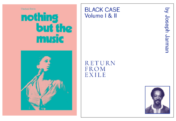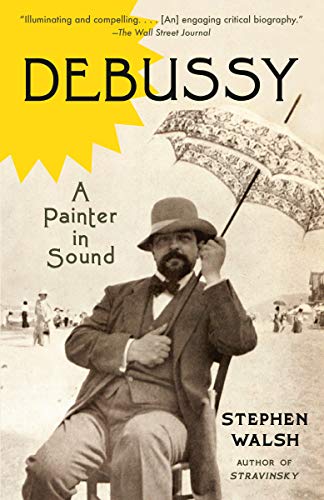
by Reviewed by Devin King

Published by Faber and Faber, 2018 | 323 pages pages
The most iconic scene from Ocean’s Eleven, the 2001 film about a casino robbery, features no dialogue. While our eyes follow the camera panning Danny Ocean’s crew as they survey the Belligio Fountains, our ears are fed the uninterrupted orchestral climax of Claude Debussy’s Clair de Lune. The stirring coupling of the violins’ highest pitches with the ascent of the cascading water is particularly remarkable given that Debussy’s piece was not written for orchestra at all. This, the third movement of Suite Bergamasque from 1890, was Debussy’s only composition for piano that year, its title, ‘moonlight’, taken from Paul Velaine’s poem of the same name. At this stage in the film, the characters have achieved their impossible goal and the soundtrack tells us so. Sustained lilting arpeggios and falling chords in Clair de Lune, played con sordino (with the mute), convey serenity more deeply than any visual image could.
The Debussy we meet in Stephen Walsh’s Debussy: A Painter in Sound is a painter, poet, and theatre enthusiast, obsessed with literature, one who embraced an artistic lifestyle in its broadest sense rather than limiting his exploits to the world of music. Here is a composer who himself orchestrated, not as the mere transfer of pieces conceived at a piano, but as inspired by Impressionist paintings (although Debussy hated the Impressionist label). Debussy layered strings and woodwind deliberately to mimic the contrast and sequencing of colour in pictures.
Among his own peers, Debussy was something of an unremarkable pianist, rebelling against standard music theory and intent on producing harmonies and chord progressions that would have sounded incomprehensible to their ears. Debussy may have entered the Paris Conservatoire at the tender age of ten, but we learn that the ‘Prodigy’ title of Stephen Walsh’s first chapter is used ironically, as he was scarcely a star pupil. At the age of eighteen, Debussy fell in love with the married soprano, Marie Vasnier, fourteen years his senior. Much of the early music he wrote, while he was still grappling with a signature style, was inspired more by her than by any of the formulaic rules and rudiments imposed at the Conservatoire.
Walsh’s description of a classical work as ‘a well-told story, with a number of narrative threads, locations and characters that must all be tied up and reconciled in a coherent way’ elucidates why there is a particular synergy between Debussy’s music, life and the visual arts. In the story Walsh here recounts, the composer Richard Wagner looms large as chief protagonist. French music from the 1870s was dominated by the overwhelming influence of the Germanic Wagner. In essence, Debussy’s early music demonstrates a fraught identity, all too familiar amongst humans, of not always knowing exactly what it is, but being certain of what it is not. Walsh’s analysis of different harmonic elements in Debussy’s music shows us how he achieved some manner of compositional independence from the Germanic sound in his early, formative years. True, Debussy uses the famous Tristan chord (from Wagner’s Tristan und Isolde, premiered in 1856) in one of his most famous compositions, Prélude à l'aprés midi d'un faune (1894), but by resolving it to a new chord, Debussy ingeniously achieves his own unique sound.
Walsh sets Debussy up as the good guy we should root for in this compositional tussle, explaining how he uses different, gentler dynamics, and arguing that Debussy’s ‘music never bullies’. Shortly after the Symbolist poet Stéphane Mallarmé commissioned Debussy to write Prélude à l'aprés midi d'un faune, the composer met Eric Satie, a fellow composer sharing his hostility towards the mainstream and towards Wagnerian dominance, after which Debussy is encouraged in moving further away from conventional harmonies.
Walsh describes the ripening of Debussy’s composition style as a lifelong evolution, inviting us to ‘follow the thread of Debussy’s development by examining each work roughly in order’, and he assists the reader by presenting a largely conventional chronology over a series of fourteen chapters. Pelléas et Mélisande (1898), he says, is a coming-of-age composition and all previous works are, metaphorically, ‘the gurglings of a baby pulling the plug out of its own bath’. These moments fall astride Debussy’s student stage in the mid 1890s, when ideas became ‘lionised’ by his increased contact with an open artistic circle. Walsh does not play mere lip service to this artistic circle, but traces their influence on the music. We learn, for example, how his melodic arabesques have swirling vocal or instrumental lines that follow the curves of Art Nouveau.
Debussy’s music sounds modern. He looked forward to the twentieth century, unfettered by any inherited rules of meter, harmony and counterpoint. Walsh tells us that of major inspiration were the Javanese gamelan orchestras, which visited Paris for the Exposition Universelle in 1889. The unique combination of gongs, glockenspiels and melody instruments left a lasting impression on Debussy and their musical design would influence his own creation of beautiful, evocative sounds. There was nothing hazy about his compositional process however. Walsh’s study explains how Debussy was exact about every single aspect of his music, creating a specific image through fresh structures, design and balance for each piece, at the cost of leaving a number of projects unfinished.
Walsh speaks in metaphor with music, but he uses literal descriptions of form, structure and harmony and, while often giving way to an analytical approach, also shares his opinions as a professor of music. In so doing, he achieves the balance of satisfying the specialist without alienating a general readership. Locating a biography in music certainly assists the fuller comprehension of Debussy’s life. The composer officially blamed illness for his slow progress on the Gigues (1912), for example. Yet, Walsh reveals he was simultaneously writing works that were amongst ‘his most perfect’. We later learn that Debussy’s ailing health and dying mother had an effect on his artistic output at this time. When, for example, in 1914, he gave up the theatre project, No-Ja-Li, telling the composer Charles Koechlin, “You compose it and I’ll sign it”, this was not lack of enthusiasm or professional indifference. Of major advantage to telling the composer’s story through the character of music is that Walsh need not conclude with Debussy’s death in 1918. The narrative continues on to cover the composer’s daughter’s death sixteen months later and the story carries on to cover his posthumous influence.
In setting up Wagner as something of the foil, Walsh describes his music as ‘too much singing, too much explanation’. Perhaps this rationalises Walsh’s own thorough detail. When his focus is on La Mer, for instance, such is the lengthy build-up when we learn, after many distractions, that Debussy finally completed it, it feels like we have lived every single one of the distractions. These distractions Walsh describes as both tangible, Debussy’s simultaneous divorce from Lilly Texier, for example, and more abstract, Debussy’s personal feelings toward the sea. On the other hand, however, just as music has a ‘natural tendency to generalise’, so too Walsh does not always set us up with so meticulous a tale. There are moments where he skips through the comprehensive narrative at speed and insists the reader keep up. In a separate discussion of Nocturnes (1899), the music again our central consideration, his statement ‘three months after finally receiving the manuscript he died suddenly at fifty six’ comes as a shock. Only closer inspection reveals that the ‘he’ here is publisher Georges Hartmann. At another moment, when the musician Maurice Ravel is reintroduced in 1907 and with him the ‘old rivalry’, it is difficult to comprehend when this was ever a new rivalry. When originally mentioned, Walsh describes Ravel as an inspiration to Debussy. Indeed, Debussy was so impressed by his Habanera (1907) that he borrowed the manuscript.
By foregrounding music and not the fine details of Debussy’s personal and private life, Walsh’s publication is pioneering. He goes deeper, finding multiple facets in the many elements of Debussy’s sketches and published works, which would appear to be something different ‘on the face of it’. The character, music, in this book is never straightforwardly music. Pelléas et Mélisande Walsh describes as a coherent love story, where sung vocal lines support the pattern of normal speech and emphasise certain words and phrases, but where, also, all is playing out behind a dream-like symbolist work, in which music unlocks the inhibitions around tragedy and violence without altering what is actually being said. In such vivid descriptions, Walsh presents a journey with music into the twentieth century that allows us to understand more fully the sounds and the life lived within it.
Angela Moran is a musician, facilitator and researcher based in Geneva. A performing pianist and violinist, Angela completed her PhD in Music at Cambridge University and subsequently published her book on music and the Irish diaspora. Angela recently presented A Very British History: Birmingham Irish I am, which was broadcast on BBC4.















click to see who
MAKE Magazine Publisher MAKE Literary Productions Managing Editor Chamandeep Bains Assistant Managing Editor and Web Editor Kenneth Guay Fiction Editor Kamilah Foreman Nonfiction Editor Jessica Anne Poetry Editor Joel Craig Intercambio Poetry Editor Daniel Borzutzky Intercambio Prose Editor Brenda Lozano Latin American Art Portfolio Editor Alejandro Almanza Pereda Reviews Editor Mark Molloy Portfolio Art Editor Sarah Kramer Creative Director Joshua Hauth, Hauthwares Webmaster Johnathan Crawford Proofreader/Copy Editor Sarah Kramer Associate Fiction Editors LC Fiore, Jim Kourlas, Kerstin Schaars Contributing Editors Kyle Beachy, Steffi Drewes, Katie Geha, Kathleen Rooney Social Media Coordinator Jennifer De Poorter
MAKE Literary Productions, NFP Co-directors, Sarah Dodson and Joel Craig